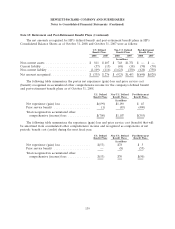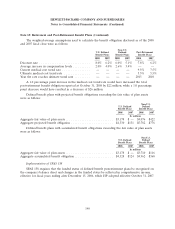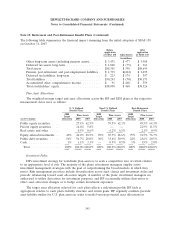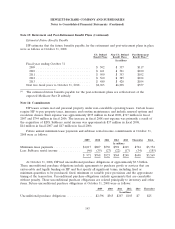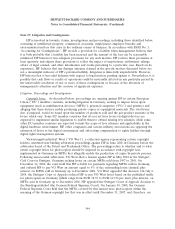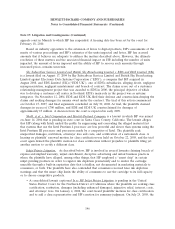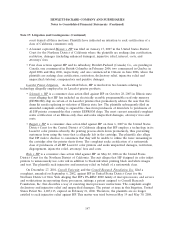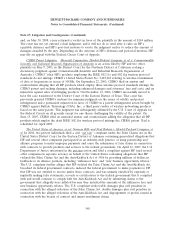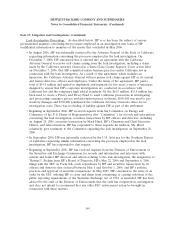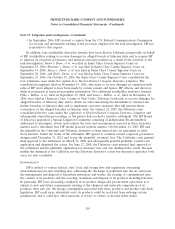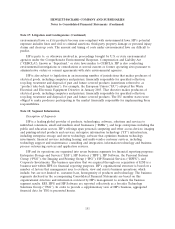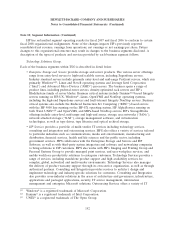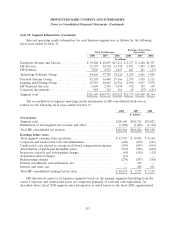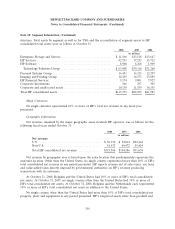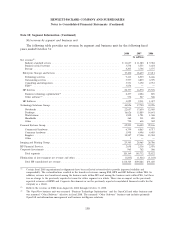HP 2008 Annual Report Download - page 154
Download and view the complete annual report
Please find page 154 of the 2008 HP annual report below. You can navigate through the pages in the report by either clicking on the pages listed below, or by using the keyword search tool below to find specific information within the annual report.
HEWLETT-PACKARD COMPANY AND SUBSIDIARIES
Notes to Consolidated Financial Statements (Continued)
Note 17: Litigation and Contingencies (Continued)
and, on May 30, 2008, a jury returned a verdict in favor of the plaintiffs in the amount of $184 million.
The court has not yet entered a final judgment, and it will not do so until after it rules on HP’s
equitable defenses and HP’s post-trial motions to vacate the judgment and/or to reduce the amount of
damages awarded by the jury. Depending on the outcome of HP’s defenses and post-trial motions, HP
may file an appeal with the Federal Circuit Court of Appeals.
CSIRO Patent Litigation. Microsoft Corporation, Hewlett-Packard Company, et al. v. Commonwealth
Scientific and Industrial Research Organisation of Australia is an action filed by HP and two other
plaintiffs on May 9, 2005, in the District Court for the Northern District of California seeking a
declaratory judgment against Commonwealth Scientific and Industrial Research Organisation of
Australia (‘‘CSIRO’’) that HP’s products employing the IEEE 802.11a and 802.11g wireless protocol
standards do not infringe CSIRO’s United States Patent No. 5,487,069 relating to wireless transmission
of data at frequencies in excess of 10GHz. On September 22, 2005, CSIRO filed an answer and
counterclaims alleging that all HP products which employ those wireless protocol standards infringe the
CSIRO patent and seeking damages, including enhanced damages and attorneys’ fees and costs, and an
injunction against sales of infringing products. On December 12, 2006, CSIRO successfully moved to
have the case transferred to the District Court of the Eastern District of Texas. That court has
previously granted CSIRO’s motions for summary judgment on the issues of validity and patent
infringement and a permanent injunction in favor of CSIRO in a patent infringement action brought by
CSIRO against Buffalo Technology (USA), Inc., a third party vendor of wireless networking products
based on the same patent. This judgment was subsequently affirmed by the U.S. Court of Appeals for
the Federal Circuit on all grounds except for one theory challenging the validity of the patent. On
June 15, 2007, CSIRO filed an amended answer and counterclaims adding the allegation that all HP
products which employ the draft IEEE 802.11n wireless protocol infringe the CSIRO patent. Trial is
scheduled for April 2009.
The United States of America, ex rel. Norman Rille and Neal Roberts v. Hewlett-Packard Company, et
al. In 2004, two private individuals filed a civil ‘‘qui tam’’ complaint under the False Claims Act in the
United States District Court for the Eastern District of Arkansas containing generalized allegations that
HP and several other companies participated in an industry-wide practice of using partnership and
alliance programs to make improper payments and cause the submission of false claims in connection
with contracts to provide products and services to the federal government. On April 12, 2007, the U.S.
Department of Justice intervened in the qui tam action and filed a complaint against HP (and several
other companies in separate actions) on behalf of the United States containing allegations that HP
violated the False Claims Act and the Anti-Kickback Act of 1986 by providing millions of dollars in
kickbacks to its alliance partners, including ‘‘influencer fees’’ and ‘‘new business opportunity rebates.’’
The U.S. complaint further alleges that HP violated the False Claims Act and the Anti-Kickback Act,
breached its federal government contracts, induced the federal government to make payments to HP
that HP was not entitled to receive under those contracts, and was unjustly enriched by expressly or
impliedly making false statements, records or certifications to the federal government that it complied
with and would continue to comply with the Anti-Kickback Act and by submitting claims to the
government that allegedly were inflated because they included the amounts of the influencer fees and
new business opportunity rebates. The U.S. complaint seeks treble damages plus civil penalties in
connection with the alleged violations of the False Claims Act, double damages plus civil penalties in
connection with the alleged violations of the Anti-Kickback Act and disgorgement of profits earned in
connection with the breach of contract and unjust enrichment claims.
148



